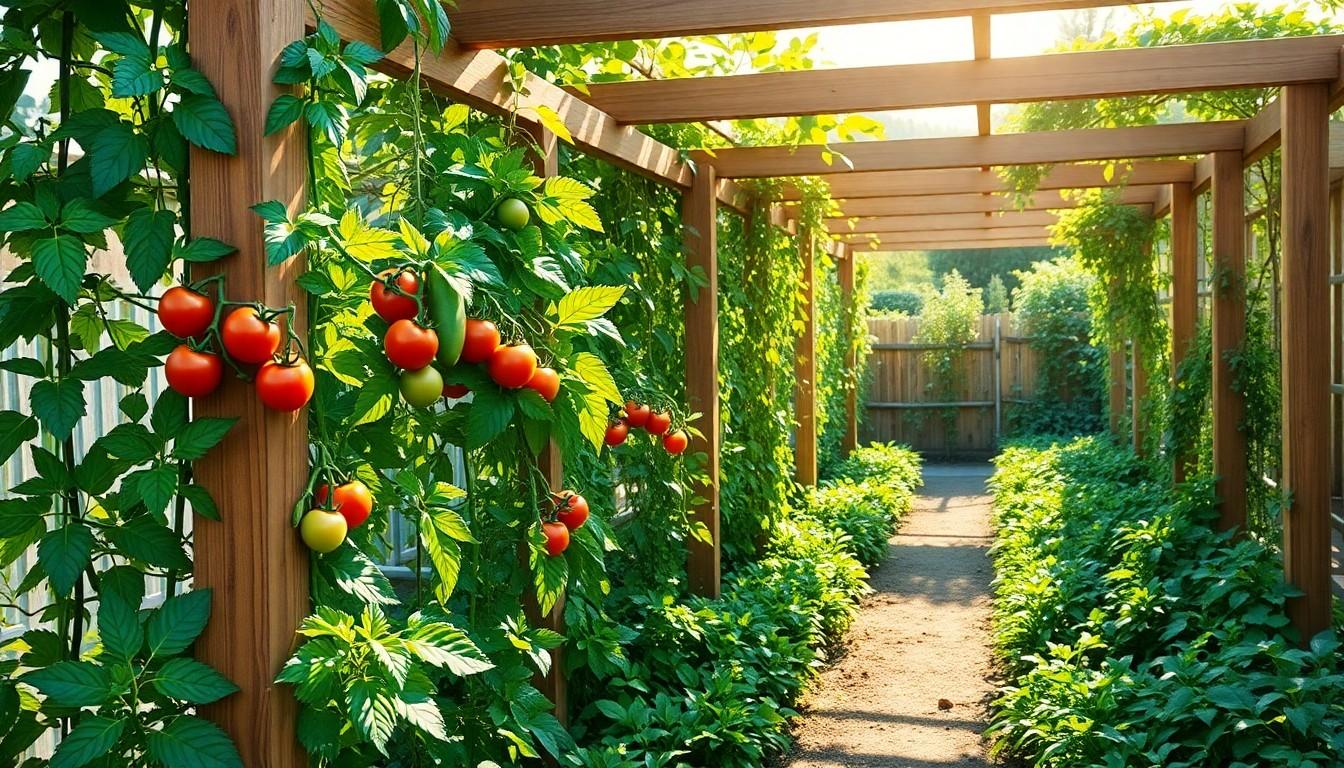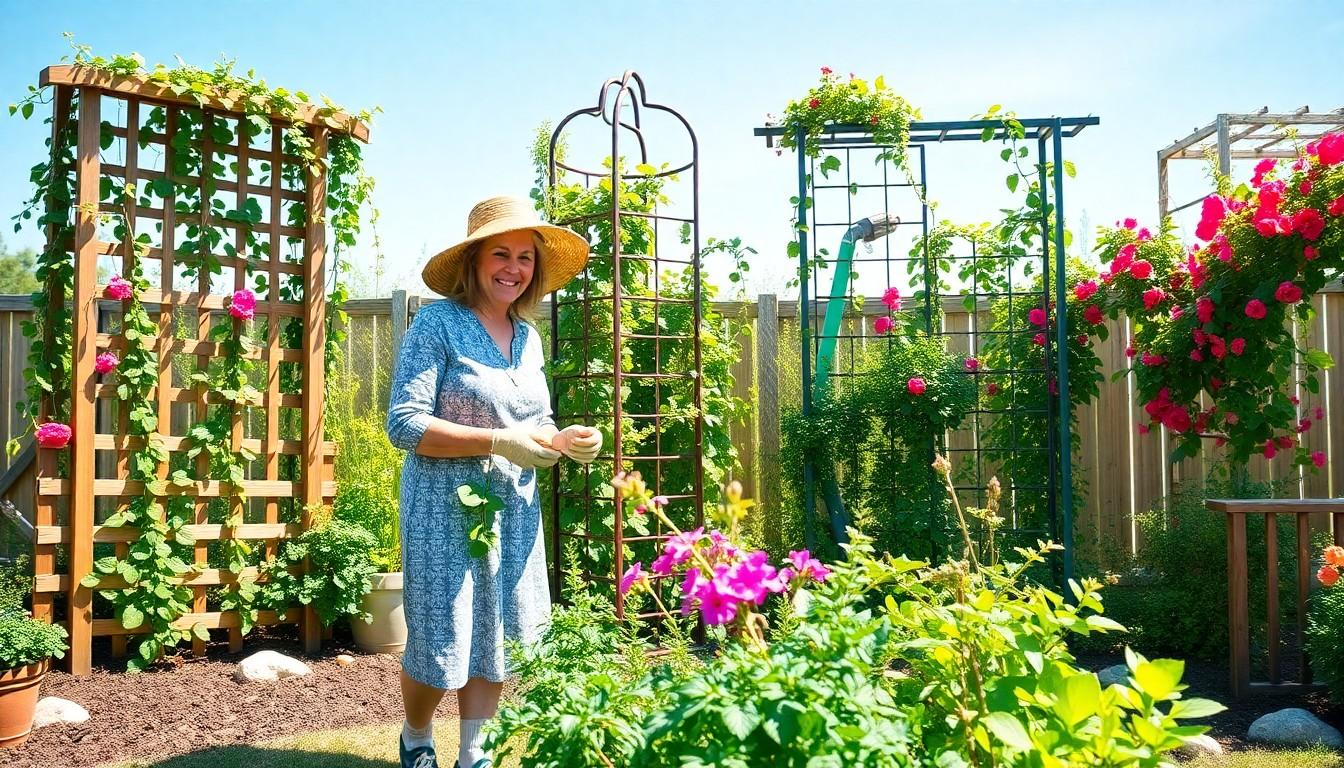Imagine a garden where plants stretch toward the sky, showcasing their vibrant blooms and lush greenery. Climbing plants can transform any outdoor space into a breathtaking vertical paradise, but they need a little help to reach their full potential. Enter the trellis—a gardener’s best friend and the ultimate support system for those ambitious vines.
Overview of Trellis for Climbing Plants Outdoor
Trellises serve as vital support systems for climbing plants, enabling them to grow upward and maximally utilize vertical space. These structures enhance aesthetic appeal in gardens, creating elegant displays. Available in various materials, trellises can be wood, metal, or plastic, providing options based on durability and design preferences.
Different designs cater to specific climbing plant types. For instance, lattice-style trellises support light vines, while robust structures manage heavier plants such as wisteria or clematis. Height and width of a trellis significantly influence plant growth. Taller trellises encourage plants to climb higher, contributing to dramatic visual effects.
Placement of a trellis impacts plant health and development. Positioning a trellis in a location that receives adequate sunlight ensures optimal growth for climbing plants. Moreover, securing a trellis against walls or fences offers additional support, aiding in stability during wind or adverse weather conditions.
Care and maintenance of the trellis are crucial. Regular inspections for wear and potential rot, particularly in wooden trellises, promote longevity. Routine pruning of climbing plants encourages healthier growth, preventing overcrowding or damage to the trellis itself.
Installing a trellis contributes significantly to a garden’s environment. These structures foster increased air circulation among foliage, reducing risks of disease. Additionally, they create habitats for beneficial insects, promoting biodiversity. Different trellis styles can complement distinct garden themes, enhancing overall outdoor decor.
Benefits of Using Trellis

Trellises provide numerous advantages for climbing plants in outdoor settings. These structures not only support plant growth but also enhance the overall garden environment.
Enhanced Plant Growth
Trellises facilitate improved air circulation around climbing plants. Healthy airflow reduces the risk of diseases that thrive in stagnant conditions. When plants grow vertically, they receive more sunlight which is essential for photosynthesis. Increased light exposure also leads to stronger, more vibrant foliage. Furthermore, proper support helps prevent damage from wind and other adverse weather conditions. Lifting plants off the ground encourages better drainage, reducing the likelihood of root rot. Climbing plants, like tomatoes or peas, flourish when nurtured with trellis systems that adapt to their growth patterns.
Space Optimization
Vertical gardening maximizes limited outdoor space effectively. By using trellises, gardeners take advantage of upward growth rather than horizontal spread. Trellises allow multiple plants to grow in a compact area without overcrowding. Utilizing vertical space leads to a more organized and visually appealing garden layout. Climbing plants, such as cucumbers or pole beans, exhibit significant growth in small plots when secured to a trellis. In addition, trellises can create defined pathways and borders, enhancing the garden’s functionality. Overall, the strategic use of trellises transforms gardens into efficient, attractive spaces.
Types of Trellis for Climbing Plants
Trellises come in various types, each with unique characteristics suitable for different climbing plants.
Wooden Trellis
Wooden trellises provide a classic look that blends well with natural surroundings. Constructed from durable woods like cedar or redwood, they resist decay and insects. Their natural aesthetics enhance garden beauty while allowing for versatile designs. Different shapes, such as lattice or flat panels, accommodate various climbing plants. Wooden trellises support heavy vines, including grapes or passionflower. Additionally, regular treatments with sealants prolong their lifespan. Proper maintenance, such as annual checks for rot, ensures continued functionality.
Metal Trellis
Metal trellises offer strength and longevity, often made from materials like aluminum or wrought iron. Their sleek appearance adds a modern touch to outdoor spaces. Withstanding harsh weather, these structures require minimal maintenance. Metal designs include arched, grid, or freestanding styles, catering to diverse climbing plants. Stronger vines, such as honeysuckle or clematis, thrive on metal trellises without concern for stability. A painted or coated finish protects against rust, maintaining visual appeal for years.
Plastic Trellis
Plastic trellises are lightweight, affordable, and resistant to rot. They come in a range of colors and styles, fitting various garden aesthetics. Their durability ensures they withstand UVA rays without fading. These trellises work well for supporting lighter climbing plants, such as morning glories or sweet peas. Additionally, easy installation makes them accessible for gardeners. Plastic designs often feature interlocking panels, allowing for customization of height and width. Regular cleaning keeps them looking fresh and extends usability.
Choosing the Right Trellis
Selecting the appropriate trellis plays a crucial role in the growth of climbing plants. Decisions impact both aesthetics and plant health.
Consider Plant Types
Understanding plant types is essential for effective trellis selection. Light climbers like sweet peas thrive with lattice-style structures, while heavier vines such as clematis necessitate sturdier designs. Assessing growth habits ensures compatibility. Vines may require more than just vertical support; they might need additional anchoring points. Gardeners should consider specific needs to maximize growth potential and visual appeal.
Weather Resistance
Weather resistance significantly affects trellis longevity and plant health. Materials should withstand environmental conditions like rain, snow, and intense sunlight. Metallic trellises often offer superior durability against harsh elements. Wooden structures, while aesthetically pleasing, require treatment for weatherproofing. Choosing materials that align with local climate characteristics promotes sustainability. Gardeners also benefit from checking for corrosion or rot to maintain the structure’s integrity. Prioritizing weather-resistant features extends the lifespan of trellises and supports healthy climbing plants.
Maintenance Tips for Trellis
Regular inspections play a crucial role in maintaining trellises. Checking for signs of wear, such as rust on metal or rot in wood, helps to catch issues early. Pruning climbing plants prevents overcrowding, ensuring that each plant receives adequate light and air circulation.
Applying wood treatments extends the life of wooden trellises. Options like sealants or stains protect the wood from weather conditions, enhancing durability. For metal trellises, a simple wipe down removes dust and debris, preserving their appearance and functionality.
Consider tightening screws and fasteners periodically. Loose connections can lead to instability, undermining the support needed for climbing plants. Replacing damaged components promptly ensures the trellis continues to provide adequate support.
Observing plant growth informs adjustments to trellis positioning. As plants mature, they may require new ties or supports to accommodate their growth, enhancing their aesthetic appeal. Timely adjustments not only promote healthy growth but also maintain structural integrity.
Utilizing organic fertilizers and mulch around the base of the trellis nurtures the plants without harming the structure. Proper soil fertility supports healthier climbing plants, reducing the strain on the trellis itself.
In addition, clearing debris from the base of the trellis improves drainage. Good drainage prevents root rot and encourages healthy growth, ultimately benefiting both the plants and the trellis structure. Regular maintenance ensures that trellises function as effective support systems, promoting thriving climbing plants in outdoor spaces.
Conclusion
Choosing the right trellis for climbing plants can transform any outdoor space into a vibrant and inviting environment. By understanding the specific needs of different climbing plants and selecting appropriate trellis designs, gardeners can create stunning vertical landscapes that enhance both beauty and functionality.
Regular maintenance ensures these structures remain effective and durable over time. With proper care, trellises not only support healthy plant growth but also contribute to the overall health of the garden ecosystem. Embracing the versatility of trellises opens up endless possibilities for creativity in garden design, making them an essential element for any outdoor enthusiast.





